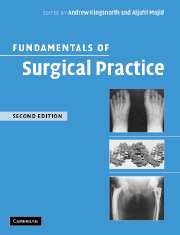Book contents
- Frontmatter
- Contents
- Preface
- Contributors
- 1 Preoperative management
- 2 Principles of anaesthesia
- 3 Postoperative management
- 4 Nutritional support
- 5 Surgical sepsis: prevention and therapy
- 6 Surgical techniques and technology
- 7 Trauma: general principles of management
- 8 Intensive care
- 9 Principles of cancer management
- 10 Ethics, legal aspects and assessment of effectiveness
- 11 Haemopoietic and lymphoreticular systems: anatomy, physiology and pathology
- 12 Upper gastrointestinal surgery
- 13 Lower gastrointestinal surgery
- 14 Hernia management
- 15 Vascular surgery
- 16 Endocrine surgery
- 17 The breast
- 18 Thoracic surgery
- 19 Genitourinary system
- 20 Head and neck
- 21 The central nervous system
- 22 Musculoskeletal system
- 23 Paediatric surgery
- Index
20 - Head and neck
Published online by Cambridge University Press: 15 December 2009
- Frontmatter
- Contents
- Preface
- Contributors
- 1 Preoperative management
- 2 Principles of anaesthesia
- 3 Postoperative management
- 4 Nutritional support
- 5 Surgical sepsis: prevention and therapy
- 6 Surgical techniques and technology
- 7 Trauma: general principles of management
- 8 Intensive care
- 9 Principles of cancer management
- 10 Ethics, legal aspects and assessment of effectiveness
- 11 Haemopoietic and lymphoreticular systems: anatomy, physiology and pathology
- 12 Upper gastrointestinal surgery
- 13 Lower gastrointestinal surgery
- 14 Hernia management
- 15 Vascular surgery
- 16 Endocrine surgery
- 17 The breast
- 18 Thoracic surgery
- 19 Genitourinary system
- 20 Head and neck
- 21 The central nervous system
- 22 Musculoskeletal system
- 23 Paediatric surgery
- Index
Summary
OCULAR INJURY
Ocular injuries may occur as a result of thermal, radiation, chemical or physical insults. If the eye or periorbital region is involved in the injury, proper assessment, including a detailed history, visual acuity testing, pupillary responses, external eye surface inspection and the inner eye structures examination, must be carried out.
If retained intraocular foreign body is suspected, appropriate investigations should be performed. These include standard, orbital, plain film radiographs to detect radioopaque foreign bodies. Computed tomography (CT) with axial and coronal cuts is helpful in the evaluation of both intraocular and periocular structures as well as the presence or degree of periocular damage. It may also show whether a patient has sustained an intracranial injury, such as subdural haemorrhage. Ultrasound is useful to localize nonmetallic intraocular foreign bodies and detect choroidal haemorrhage, posterior scleral rupture, retinal detachment and subretinal haemorrhage.
Details regarding the setting of the injury are important and give an idea of what to look for and exclude in the physical examination.
The equipment required to perform an initial eye examination includes: vision card, penlight, topical anaesthetic eye drops, direct ophthalmoscope, sterile fluorescein strips, gauze, eye pads, eye shields, Q-tips and irrigating solution.
Topical anaesthetic may be needed to control the pain and discomfort before physical examination can begin. However, if an open injury of the globe is evident or suspected, it is important not to instill such medications in order to prevent toxicity to the intraocular structures.
- Type
- Chapter
- Information
- Fundamentals of Surgical Practice , pp. 391 - 414Publisher: Cambridge University PressPrint publication year: 2006



